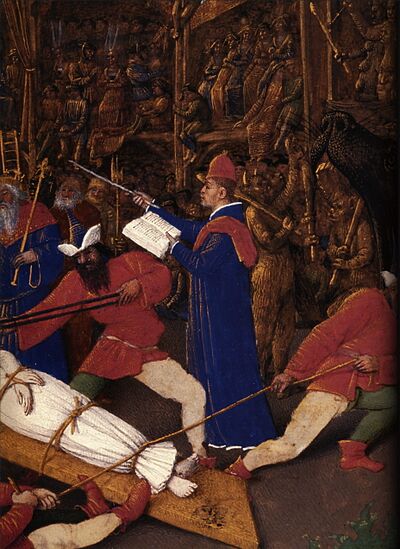In Writing
Documenting stage action and techniques
The play text is a vital means to communicate how a play is to be performed, containing the lines to be spoken by the actors, but also information about the staging of the performance. However, the play text of today was unknown in the Middle Ages.
Medieval theatre was very different to that of today. Plays were performed in improvised spaces, often outdoors. The religious plays, representing episodes from the bible, were performed not by theatre professionals in the modern sense, but by ordinary people under the control of church, civic or guild authorities. In any one place, there might be many years between performances. Plays were documented through scripts, both as a set of instructions for future performance, and as a record of what had taken place for future reference.
The conducting scroll was a director’s script used in late medieval theatre. Unlike most writings of the time, it was designed as a scroll. The Regens or Magister Ludi (Latin for ‘play director’) used it to direct the performance of the drama. Unlike most modern scripts, it contained not only the words to be spoken and stage instructions but also precise instructions on stage construction and scenery, costumes and make-up, as well as practical performance notes, including a list of persons and the keywords for the actors.
Some of the best-known conducting scrolls are the records of the Frankfurt Passion Play from the early 14th century, the Alsfeld Passion Play, the Friedberg Procession Play (1465) and the so-called Sterzinger Szenar, a version of the Neidhartspiel (a play by the 13th century poet Neidhart).
The Frankfurt Conducting Scroll describes the oldest Passion play of several days’ duration and is the oldest known record of a director’s book. The scroll is over four metres long, and has the title Incipit ordo siue registrum de passione domini (‘here begins the order or register of the Lord’s Passion’) and the end note ludo fiat finis (‘let the play end’). It consists of eight strips of parchment glued together to form a roll. The scroll has continuous writing without interruptions. The scroll uses red and black ink to distinguish the rubric (instructions) from the text, a method then common in liturgical manuscripts, just as a modern day stage manager might mark up the prompt copy in different colours to make it easier to find the needed information in a hurry. The scroll has numerous changes and additions in the margins – both to the spoken text and the instructions – testify to the changes in the performance practice of the play during the first half of the 14th century. The changes, only slightly newer than the basic text, were at least partly made by the original writer.
English theatre in the Middle Ages also used a master text, containing stage directions as well as the spoken words. These were more commonly bound as a book, rather than a scroll, but the principle is the same, with again the use of red and black ink. All plays had a master version of the text, from which the parts could be copied. Parts consisted of just the lines for one actor, with a word or short phrase of the preceding line to act as a cue. Actors therefore did not read the whole play, but learned just their own lines and the cue which they should respond to. Actors were only given their part written out, while the master copy of the play was held by the civic authorities as a record of the authorised text that was allowed to be performed. Any copies had to be checked against the master version.
The stage directions were generally written in after the performance – they were therefore a retrospective record of what had taken place during the performance, and perhaps instructions for future performers. Stage directions could include practical information on how to create stage effects, including violent acts such as murders and hangings, or miracles such as making water spring from the ground. The late 12th century play Le Mystère D’Adam describes how to safely enact the murder of Abel by Cain:
Then shall Abel genuflect towards the east. And he shall have a pot hidden in his clothes, which Cain shall strike as if he were really killing Abel. Abel, moreover, shall lie prostrate, as if dead.
Or this example from the Lucern Passion Play, where Mosses must strike the earth to create a spring of water:
Now the water comes with full force. They all run to drink, pressing forward in a throng. Note: the rock is to be made artificially, namely a container which will take a good amount of water under a cover, arranged and made so that it looks like a rock with at three or four places glass or brazen bungs sticking out which Moses strikes out when the water is to flow.
In a context where plays were performed intermittently, by people who were not full-time theatre makers, the play text had a vital role. It both recorded and passed on not only the words to be spoken, but also the other actions, and – crucially – the staging methods and techniques by which they could be carried out to give the desired effect.

